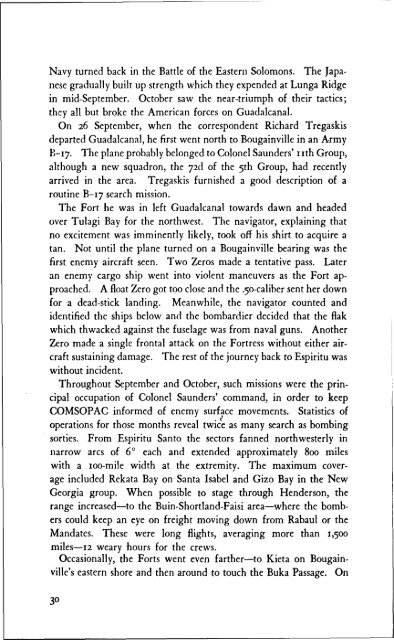Pacific Counterblow - Air Force Historical Studies Office
Pacific Counterblow - Air Force Historical Studies Office
Pacific Counterblow - Air Force Historical Studies Office
Create successful ePaper yourself
Turn your PDF publications into a flip-book with our unique Google optimized e-Paper software.
Navy turned back in the Battle of the Eastern Solomons. The Japanese<br />
gradually built up strength which they expended at Lunga Ridge<br />
in mid-September. October saw the near-triumph of their tactics;<br />
they all but broke the American forces on Guadalcanal.<br />
On 26 September, when the correspondent Richard Tregaskis<br />
departed Guadalcanal, he first went north to Bougainville in an Army<br />
B-I 7 . The plane probably belonged to Colonel Saunders' i ith Group,<br />
although a new squadron, the 72d of the 5th Group, had recently<br />
arrived in the area. Tregaskis furnished a good description of a<br />
routine B-1 7 search mission.<br />
The Fort he was in left Guadalcanal towards dawn and headed<br />
over Tulagi Bay for the northwest. The navigator, explaining that<br />
no excitement was imminently likely, took off his shirt to acquire a<br />
tan. Not until the plane turned on a Bougainville bearing was the<br />
first enemy aircraft seen. Two Zeros made a tentative pass. Later<br />
an enemy cargo ship went into violent maneuvers as the Fort approached.<br />
A float Zero got too close and the .50-caliber sent her down<br />
for a dead-stick landing. Meanwhile, the navigator counted and<br />
identified the ships below and the bombardier decided that the flak<br />
which thwacked against the fuselage was from naval guns. Another<br />
Zero made a single frontal attack on the Fortress without either aircraft<br />
sustaining damage. The rest of the journey back to Espiritu was<br />
without incident.<br />
Throughout September and October, such missions were the principal<br />
occupation of Colonel Saunders' command, in order to keep<br />
COMSOPAC informed of enemy surface movements. Statistics of<br />
operations for those months reveal twice as many search as bombing<br />
sorties. From Espiritu Santo the sectors fanned northwesterly in<br />
narrow arcs of 6' each and extended approximately 8oo miles<br />
with a xoo-mile width at the extremity. The maximum coverage<br />
included Rekata Bay on Santa Isabel and Gizo Bay in the New<br />
Georgia group. When possible to stage through Henderson, the<br />
range increased-to the Buin-Shortland-Faisi area-where the bombers<br />
could keep an eye on freight moving down from Rabaul or the<br />
Mandates. These were long flights, averaging more than 1,500<br />
miles-12 weary hours for the crews.<br />
Occasionally, the Forts went even farther-to Kieta on Bougainville's<br />
eastern shore and then around to touch the Buka Passage. On<br />
30
















